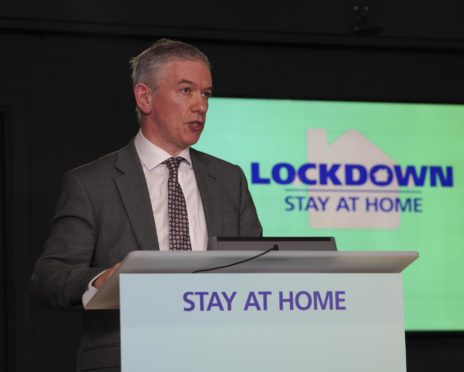Scotland’s chief medical officer has defended the Scottish Government’s “cautious” roadmap out of lockdown.
Nicola Sturgeon yesterday unveiled plans for easing restrictions, which could allow the stay-at-home order to be lifted on April 5, with the mainland returning to Level 3 from April 26.
The Tories described the roadmap as a “holding document” and said people had been l0oking for hope, while industry bosses, including those in hospitality, were left dismayed at the lack of clarity.
But on BBC’s Good Morning Scotland today, Dr Gregor Smith defended the slow and steady approach.
Latest on the lockdown
- MSPs question Sturgeon’s plan to unlock Scotland
- Scotland treading with caution so virus cannot ‘gallop away’
- Nicola Sturgeon: ‘I want this lockdown to be Scotland’s last’
He also insisted that plans to return all regions to Level 3 – despite the low case numbers in the north of Scotland – would help to curb the spread of coronavirus.
“Clearly we can’t stay in lockdown forever,” he said.
“But a lot has changed since we left lockdown last summer. There’s a new variant that we know has a large amount of transmission. It’s potentially causing more illness and potentially causing more hospitalisations, but we also have the positive news of the vaccination programme.
“We’re now seeing a little bit of levelling off but we don’t want to reciprocate a return of the R number above one.”
Asked if he thought it was fair that places like Aberdeen, which has around 26 cases per 100,000 compared to the Central Belt, should automatically be returned to Level 3, Dr Smith said it was about stopping the spread in this higher risk areas.
He said: “It’s important that we don’t allow those high case rate areas to spread into other areas. That’s why we think the slow and steady approach is best.
Covid in numbers
“We’ve seen from experience in the Western Isles how little it takes for the virus to rapidly take off in more rural areas.”
Dr Smith said that the government was in close contact with public health and local authority chiefs on a regular basis and that they were helping to chart the best way out of restrictions.
“People understand that the new variant accounts for 90% of cases and transmission, which means there is a need for caution as we approach this exit,” he said.
“We don’t want to tip the balance in its favour and allow more contact between people than necessary and cause that virus to grow exponentially again. If we do that, we may have to go back the way. With this cautious approach we are able to monitor each phase as we go through and I think that’s the right approach.”
